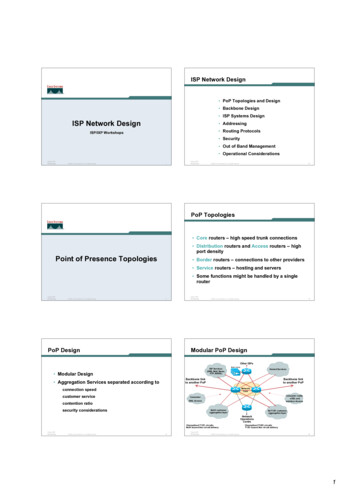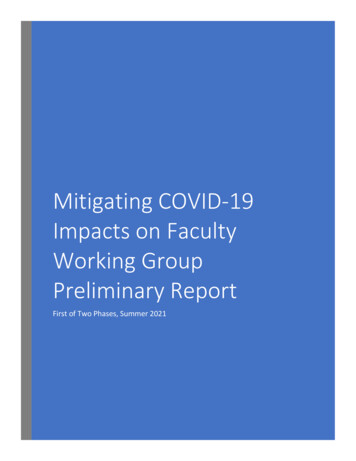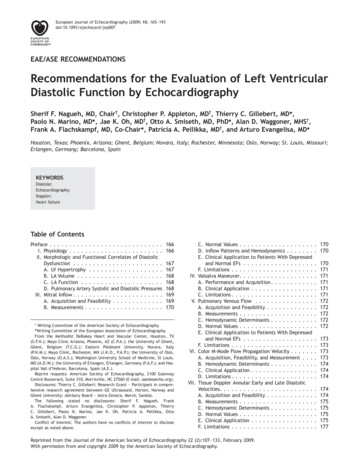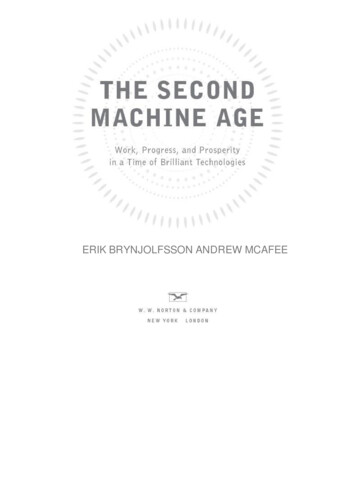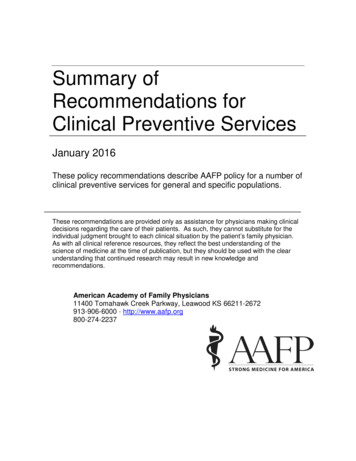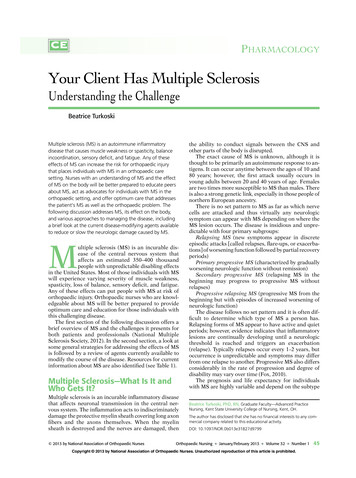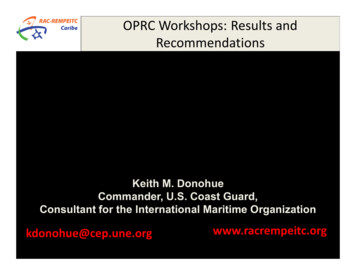
Transcription
OPRC Workshops: Results andRecommendationsKeith M. DonohueCommander, U.S. Coast Guard,Consultant for the International Maritime g
Offshore Oil & GasOil RefineriesTankerTerminalsInterest, Exploration, ProductionExploration, InterestRefineries, offshore installations,navigational hazards, oil terminal,chemical ffic2
Year Spill AmountFFFFFFFFFFFFFFFFFFFFFF(millions of Liters)1962 ARGEA PRIMA, Guanica, Puerto Rico111967 Humble Oil pipeline, offshore leak, Louisiana 251968 WITWATER, near Galetaisland, Panama31970 Offshore Platform, Well blowout101971 SANTA AUGUSTA, St. Croix, U.S.V.I 13 Crude1973 ZOE COLOCOTRONIS, Puerto Rico5 Crude1975 GARBIS Florida Keys US.24 .5 Crude1976 Pipeline Rupture, Corpus Christi,TX.1 Crude1977 Unidentified Vessel Guayanilla Bay, PRCrude1978 HOWARD STAR, Tampa,Florida US .15 20% Crude1979 BURMAH AGATE, Texas US5-411979 ATLANTIC EMPRESS, off Tobago1581979-1980 IXTOC I, Well blowout528-1626 Crude1984 ALVENUS, Louisiana US251985 RANGER, well blowout,Texas, US24-521986 Reineria las Minas, Panama8 Crude1991 VISTA BELLA Barge, off St. Kitts and Nevis 21994 BERMAN, San Juan, Puerto Rico.3 Crude1997 NISOS AMORGOS Tanker, Gulf of Venezuela 3.21999 BLUE MASTER, Galveston, Texas.1 #4 fuel1999 PARNASO, Cuba.15 #2 fuel1999 GOLDEN MARE, Colombia.25 #4 fuel
Caribbean Currents5
Vista Bella 199113,000 Bbls No.6 Fuel OilSank in 2,000 ft of water12 NM East on Nevis6-10 kt windsPuerto RicoUS Virgin Isl.UK Virgin Is.Saba (NL)St. Martin (NL)St Barthelme(F)St Kitts & Nevis6
2016 Casualties(Last 6 months)Aug:Aug:Sept:Nov:Nov:Nov:Nicaragua, Refinery Fire (Pacific)Puerto Rico, Ferry FireMexico, Veracruz Tank Ship FireTrinidad and Tobago, Pipeline SpillsJamaica, 3 Spills in Kingston Harbor over 2 DaysVenezuela, Pipeline Rupture, Southern Anzoategui7
Regional OPRC Plans
Caribbean Island OPRC Plan
Sub-Regional Level 2IMO Training CourseOil Pollution Preparedness,Response and Co-operation (OPRC)14--18 Nov 201614Pointe-à-Pitre, GuadeloupeAntigua and Barbuda, Bahamas, Grenada, Guyana,Haiti, Saint Lucia, Trinidad and Tobago, SaintVincent, and GuadeloupeOSRL,ITOPF,CEDRE,CEREMA10
Tour of SpillEquipmentStockpile11
Beach Washing Demonstration12
Live Media Training13
Government of France (CEDRE)2004 Surface Data Buoy StudyMay 4, 2004Mar 17, 2004The Centre ofDocumentation,Research andExperimentation onAccidental WaterPollution (CEDRE)Feb 26, 2004Mar 8, 2004Dec 8, 200314
IMO Regional Workshop on Oil SpillContingency Planning13--16 Dec 201613Nassau, Bahamas15Polaris,OSRL,ARPEL,DariosMiranda.Antigua and Barbuda, Bahamas, Barbados, Belize, CostaRica, Grenada, Guatemala, Jamaica, Saint Lucia,Trinidad and Tobago, Panama
Strategic Planning Steps*1. Clarify Program Mandates2. Identify/Understand Program’s Stakeholders- Develop/Refine Mission & values3. Assess Program’s:- Strengths, Weaknesses, Opportunities & Threats4. Identify & Frame Strategic Issues of theProgram5. Formulate Strategies to Manage the Issues*Bryson & Alston
Development of Table TopExercise Scenarios and Injects
RETOS Global PerformanceAnalysis
RETOSTM
NCP (last update)ICS as model for OSRRisk AssessSens. MapPriority SitesExercisesAntiguaJuly 2016YIn progressYYTier 1 (Comb) 2015,Ind/CGBarbadosJan 2013YNYN2013/14 Tier 1, Ind(Comb)Spill 2016 Tier 2Granada?NNNN2012 Tier 1, Ind/CG(Deploy);St LuciaAug 2015YNYY2016 Tier 1, Ind/CG(Comb);Spill 2013 Tier 3;Spill 2014 Tier 2Trinidad2014YNYYSpill 2013 Tier 3; Spill2016 Tier 1EquipmentAlt. Tech.Ind (D)Disp list, Zones, ISBInd, (MOU), (D)Policy, Not in NCP,;No ISB policyInd./Nat(1)Not in NCP(Fisheries); No ISBpolicyInd/Nat(1), (D)Policy for disp.;proced. not in NCO;ISB missingInd/Nat, (MOU), (D)Disp Zones ListWildlifeNCP? – XHumane Soc.Not in NCP - XNot in NCP – XVet. UniversityNot in NCP - XNCP - Wildlife CenterTracking, Modeling,SCATVisual/Civ Aviation;SCAT?; Model ?Visual/CG; SCAT;Model ?Visual/Civ. Aviation;SCAT X; Model ?Visual/CG; SCAT X;Model XVisual/Civ Aviation;SCAT; Model ?Sampling/LabsNDP/NCP X/CEHIRegionalLab/ NCP XRegional / NCP XRegional / NCP YNCP Y/ IMA, CARIRIWasteWest Indies - exportIncineration; ExportStored/ MinimumExportIncineration; Haz LFIncineration; Haz LFNotifications TestedAnnuallyAnnuallyAnnuallyAnnuallyAnnually
TOPICNCP (last version)ICS as model for OSRRisk AssessmentSens. MappingPriority SitesExercises & DrillsBahamas2011YESYESNONOBelizeOct 2011YESNONONOApril 2014-Tier -JointTabletop/EquipmentJuly 2016-Tier 2-GovernmentFeb 2016-Tier 1TabletopIndustrial/FeedbackActual Spill Sep 2015, Tier 2GovernmentIndustrial twice/yearCosta RicaJuly 2016 (not adopted)YESNONONO2016-Tier aJune 2014YESNONONOPanama2012 (not adopted)YESYESYES?2014-Tier 3-COCATRAMTabletop/Equipment2015-Tier 1-IndustrialTabletop/EquipmentFeb 2016-Tier 1-JointTabletopIndustry does once/yearActual Spill 25 Nov, Tier 1-2Dec 2015-Tier 2-EquipmentActual Spill 2008 Tier 3Industrial (2015 Inventory)Indsutrial/Government (Tier2)Memorandum ofUnderstandingIndustry Tier 2Panama Canal (Tier 3)Contract with PrivateDispersants are not allowedISB not allowedDispersants zones.Industry has dispersants andequipmentDispersants list from EPAISB only for offshoreDispersants list approved.Dispersants stock andequipmentISB ?YES – NEPA responsible andVet Division. Have personneland equipmentYES – Through Ministry ofEnvironment. Haveequipment and peopleEquipmentIndustrial/Government (Tier1)Mutual Aid AgreementAlt. TechniquesNot definedApproval Case-by-caseEquipment but notdispersants ProductsApproved ListISB and DispersantsimprobableWildlifeYES – In the National DisasterPlan. Agricultural Dept., HaveEquipment and personnelTraining, MonitoringSCATRoyal Bahamas Air Force Weather Dept. GIScapabilitiesSCAT – 25-30 persons trainedIs not in the NCP. BelizeDefense ForceThree dronesTrajectory ?SCAT included in the NCPNot trackingNot trajectory modelingMentioned in the NCPNot SCATFuerza Aérea deGuatemala MarinaModeling not identified inNCP done by MarinaSCAT Ministry of Environment?Tracking by Coast Guard (JDF)Trajectory MeteorologicalYES – ACP and OPC. Is in theOfficeNCPDroneSCAT – ACP and OPCSCAT by NEPA and JamaicanDefense ForceSampling/LabsYES – Dept. of Environmentaland Health. National andInternationalNational Disaster Plan has theinfoYES - Dept. of EnvironmentLabs in country andGuatemalaIs specified in NCPYES - SIMAR-Universidad deCosta RicaLocal lab.Specified in NCPYES – Ministry of Energy andMinesNot specified in NCPYES - NEPANot mentioned in the NCPYES – ACPLabs ACPSpecified in NCPWaste ManagementYESNot recycled wastes areincineratedExport wastesHazardous wastes are notmanagedYESIncineratorsNot recycled wastes land fillYES – Asphalt and cementNot recycled ?YES – IncineratorsNot recycled IncineratorsYES – incineratorsWaste storage facilitiesWastes are buriedYES – OPC is in chargeNot clear proceduresNotificationsRevision of numbersonce/yearRevision once/yearAprox once/yearRevision is done duringexercises. At least once/yearNot a list of numbers. Just amention of officesRevisions are done whitexercisesIndustrial/Government (Tier1)Government Tier 1 (2010inventory)Policy only for dispersantsISB NotTwo dispersants listed. Mustbe approved by Ministry ofHealth ISB can be approvedby Minister of Health incritical situationsNO – No mention of wildlifein the NCPYES – Not documented in theNCP. Is part of a nationalNOproject of Ministry ofNGOs have some equipmentEnvironment y ConsejoNacional de Áreas Protegidas
National-Level RETOSAssessmentsBahamas Jamaica PanamaCategoryValueLegislation, Regulations, Agreements 88%88%88%Oil Spill Contingency Planning85%71%71%Response Coordination100%100%70%Health, Safety & Security100%100%100%Operational Response88%75%94%Tracking, Assessment & Information Management100%83%100%Logistics100%83%75%Financial & Administrative Considerations83%83%100%Training & Exercises75%44%100%Sustainability & Improvements83%58%92%Total89%76%84%Belize Costa Rica Guatemala Antigua Barbados Grenada St. Lucia %100%94%100%83%100%100%33%88%
Master List ofNational & RegionalPreparedness &Response ProgramIssuesValidate & Supplementeach other
National Level Results Identified MandatesIdentified StakeholdersConduced a SWOT AnalysisIdentified Master Lists of Concerns & Issues- TTX- RETOSTMParticipants departed workshop with outlinecomponents of a strategic plan framework that can bedirectly used for implementing improvement plans forbuilding capacity and making needed changes toNational Programs
Sub-regional Level III Workshop onOPRC & IMO’s Guidance on theImplementation of an IncidentManagement System20--25 May 201720Nassau, The BahamasOSRL,,Gallagher,CTEH, NOAAThe Bahamas, Belize, Colombia, DominicanRepublic, Guyana, Haiti, Jamaica, Mexico, Saint Kittsand Nevis, Saint Lucia, Saint Vincent and TheGrenadines, Suriname, Trinidad and Tobago25
Spill Scenarios ConsideringCurrents
X
Offshore Exploration Activity
Spill ScenarioX
Potentially anges after update of scenarioNotification to nationalparties, countries, UScoastguardIMS will be set upwith ministry ofenvironment inchargeEquipment not sufficient, ORSL willbe contacted (standing agreementin place)Will set up joint operation withCuba (two responses, coordinated)and US conform MTOPDominican Republic Notification of (deputy)oil spill coordinatorHaitiNotification of (deputy)oil spill coordinatorJamaicaNotification of (deputy)oil spill coordinator-JIC will be set up. Shiprepresentative is invited. Cubaauthorities will be contacted online(as practiced in exercises)-----
Potentially affectedcountriesGuyanaNotificationTrinidad & Tobago-SurinameYesStand up IMSSt. Lucia--St. Vincent--Notification toministries, othercountries (Suriname,T&T, Venezuela), oilcompany (Exxon),USCG, RAC/REMPEITC(maybe), other islandsIMS· No system in place to setup IMS. Unclear whowould be in charge· Role of participant:render advise how toformulate plan· Tier 3· No bilateral agreement inplace with Suriname torespond-ResourcesResources are insufficient to dealwith this scenario, will have to bearranged from abroad. No MOU’sin place.Changes after update ofscenario-Oil companies have equipment· Notification to contactwhich can be used for other spillspoints in region, ministries(MOU in place), agreement withfor maritime sector andOSRLenergy, as well ascoastguard.· IMS will be set up (ICSexperience in place)· No experience in settingup JIC for region.· Equipment of national oilcompany will be employed,expertise on IMS, manpower· Resources required: willcontact resource providers (noMOU’s in place)ST Lucia has MOU with local oilStand op IMSfacility regarding responseequipment (can also useequipment for other types ofspills, but have to pay).Not specified.
Table 6.3-Exchange of information between countries is requiredSaint Vincent: regional SAR Coordination Centre in Barbados?Joint SAR Centers in Caribbean (i.e. also a discussion item from the November 2016 OPRC workshop in Guadeloupe)might be able to help outNo coordination exercises between countries in the affected area have been done so farSaint Lucia has an MOU with a local oil facility regarding response equipment (can also use equipment for other types ofspills, but have to pay). Trinidad and Tobago, and Dominican Republic also have similar arrangements.Many countries may be reluctant to provide equipment to another country if there is a possibility (even if slight) thatthey may become impacted by the spill at a later date.Table 6.4··········Regional coordination and communication aspects discussed in relation to scenario 2Potential resources to be shared with other countriesSuriname: has personnel trained in ICSSaint. Vincent: could provide ship drivers from the Coast GuardMexico: has extensive experience in their Environmental Protection AgencyBelize: could provide waste management expertise and response expertiseColombia: could provide experienced Naval officersJamaica: experienced disaster prevention office for planning tasks in an IMSTrinidad: has dispersant experienceGuyana: could provide manpowerBahamas, Curacao: could provide aircraftColombia, St. Kitts: could provide drones for spill monitoring
Actual Spill Report: 23 April 2017Petrotrin Refinery, Pointe-a Pierre, Trinidad300 bbls from Tank #70 (150,000 bbl capacity)Fuel Oil/ Bunker Oil - 380 Centistokes
80 Oiled Pelicans
GOLFO DE PARIAPENÍNSULA DE PARIAGulf of PariaParia:: 20 km of beachIsla Margarita: 11 km of beachLa OrchilaOrchila:: 3 km of beachLos RoquesRoques:: beach areasARCHIPIÉLAGO LOS ROQUES E ISLA LA ORCHILA
Bonaire: 20 km east coast beaches, lagoons & rocky shoreCuracao Klein Curacao 50 km of north coastAruba 30 km of beach 50% coverage National Park/Natural Pool closed
Oil Consistency Venezuela: liquid oil ABC Islands: weather oil patches, just below surfaceRef: il-spill-spreads-bonaire
23 April Petrotrin Refinery PointePointe--a Pierre27 April: Venezuelan - Gulf of Paria29 April: Paria coasts12 May: Isla Margarita14 May: Los Roques & La Orchila26 May: Bonaire28 May: Curacao & Klein Curacao29 May: Arubala
Trinidad & Tobago, Venezuela,Bonaire, Curacao, Aruba Coordination via RAC/REMPEITC-Caribe– Daily Calls– Tech Assistance– Sample Procedures & Exchange 5 countries 4 laboratories Agreed procedures
Trinidad & TobagoResponse National Oil Spill Contingency Plan à Tier 2 Dispersant applied– to heavy patches of oil– heavy sheen in the Gulf of Paria Aerial surveys for monitoring & effectiveness Communication & sample exchange withVenezuela (bilateral agreement) Clean-up & remediation efforts
Venezuela & ABC IslandsResponse Clean-up of affected beaches Rehabilitation of birds Monitoring Aerial surveillance: spill not visible
Lessons Learned Lack of familiarity with notification (POLREP) procedures Effective coordination between Trinidad & Venezuelabased on agreement No Responsible Part No – No Personnel à Volunteers– Little Equipment & PPE– No means to Monitor / Make Trajectories– No Waste Management
IMO Sub-Regional OPRC Workshop:Oil Spill Response Equipment,Simulation Exercises & Co-ordinationwith Neighboring Countries.2-6 Oct 2017Cartagena, ColombiaThe Bahamas, Barbados, Colombia, Cuba,Curacao, Guyana, Honduras, Jamaica, Mexico,Panama, Suriname, and Trinidad and TobagoOSRL,ExxonMobilT&T Salvage;LAMORVARICHEM.
Equipment Deployment
Technical Expert Panels
Development of IncidentAction Plans
Evaluate Concepts from MTOPFor Regional PlansRegionally
Multilateral Coordination Team ? Promoting information sharing on offshore safety? Notification?
Master List of RegionalConcerns, Issues & Gaps Baseline ESI maps, coastal zone assessments, andbaseline assessment of coral reefs Vague in-situ burning & dispersants policies– no pre-approved zones No temporary oil storage & waste disposal plans Equipment availability in region unknown – needassessment No enforcement/penalty laws Regional notifications à drills Equipment to detect, assess, or monitor. Few, if any on water assets No funds for national responses Regional, national and interagency coordination à IM
Recommendations – Assessment Conducted risk assessment throughout WCR /each State– Assess Regional Equipment Stockpiles & Availability– Assess ability to attain Tier 1 OPRC capability eithernationally or with bi-lateral, multi-lateral and/or regionalagreements– Utilize RETOS
Recommendations - Plans Integrate offshore oil and gas into the WCR plansand/or enhance offshore oil and gas in plans wherealready existing Add lists of equipment/stockpiles/contacts to theCaribbean Island OPRC Plan Add Detailed National Information & OffshorePlanning to Regional Plans
Recommendations - Plans Connect regional plans– Central American OPRC & Caribbean Island OPRC– link/merged under one framework– Explore how CARICOM, & CDEMA can beused to facilitate legal framework Have regional & national oil spill contingencyplans translated in all working languages Establish connection & ensure availability ofinformation between COCATRAM andRAC/REMPEITC-Caribe (Plans, ESI maps, etc.)
Recommendations – Technical Assistance Support States in:– Setting up multi- & bilateral agreements.– Development of sub-regional Joint Communication Plans– Writing implementing, compensation & liability legislature Facilitate regional exercises on a regular basis:– To establish communication, identify resources, cross-border dispersantpolicies, increased understanding of offshore oil operations.– At least one WCR Tier 3 Table Top Exercise every 2 years Focus Additional Training On– Incident Management, OPRC, financial mechanisms, claims,compensation, civil liability, legislation development, spill monitoring,National Level & use of online software for spill trajectories
Recommendations – Technical Assistance Form a Regional Emergency Response Advisory Team– Regional Assistance Agreements– Contacts for Technical Assistance Fully established RAC/REMPEITC-Caribe as Regional SpillReporting & Notification Centre Establish partnerships with other regional coordinationcenters in WCR CEDEMA, MSRCs, DEWETRA, Panama Humanitarian Hub
Recommendations – Portal Development Develop a regional online information platform:––––––––Connected within RAC/REMPEITC-Caribe’s website.Web-based Caribbean Pollution Reporting FormNational contact / notification informationTechnical assistance links/contact informationWebchat system to activate in times of spillsALL National contingency plansNational and regional equipment stockpiles;All Environmental Sensitivity Index (ESI) maps connectedon a single Google Platform– Offshore platform, terminals, pipelines & wrecks locations– Relevant documentation such as best practices
F 1984 ALVENUS, Louisiana US 25 F 1985 RANGER, well blowout,Texas, US 24-52 F 1986 Reineria las Minas, Panama 8 Crude F 1991 VISTA BELLA Barge, off St. Kitts and Nevis 2 F 1994 BERMAN, San Juan, Puerto Rico .3 Crude F 1997 NISOS AMORGOS Tanker, Gulf of Venezuela 3.2



